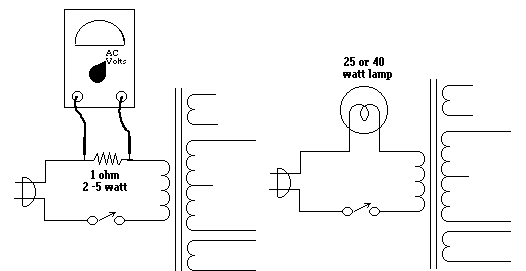Monitoring The Primary Current
 |
Two methods to monitor the transformer primary current are pictured above. In
the first example, a 1 ohm 2-5 watt resistor is placed in series with the
primary winding. A voltmeter, set to read AC volts on the 5 or 10 volt scale
is hooked across the resistor. The current that flows in the primary winding
will cause a voltage drop across the resistor that is directly related to
the amount of current. A 1-amp current flow will drop 1 volt across the
resistor, so the amount of current can be read on the voltage scale. A good
transformer will show only a few milliampers of current in the primary.
If when bringing the voltage up with the variable transformer, the current
begins to rise rapidly above .5 to 1 amp (.5 to 1 volt on the meter), a short
is indicated and no further testing should be done until the problem is
resolved. In using this method to measure the primary current, do not
plug the transformer directly into the AC line. If it is shorted and draws
heavy current the voltmeter may be damaged and the resistor will become very
hot almost immediately. Always use the variable transformer to bring the
primary voltage up slowly.
In the second example, a 25 or 40 watt lamp is connected in the same manner
as the resistor. The brightness of the lamp is use as an indicator of the
primary current. The lamp will glow dimmly on a good transformer, or brightly
if the transformer has a shorted winding.
Press the Back button on your browser to return to the previous page

